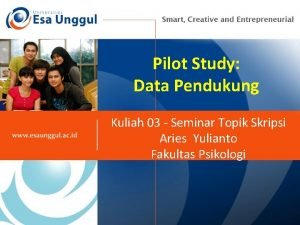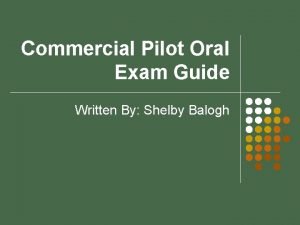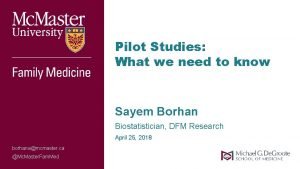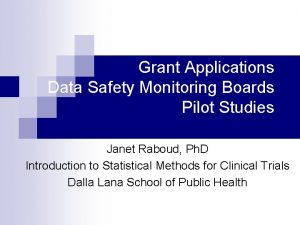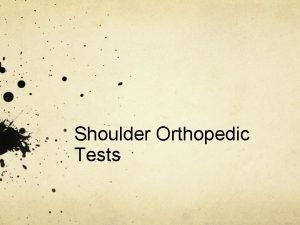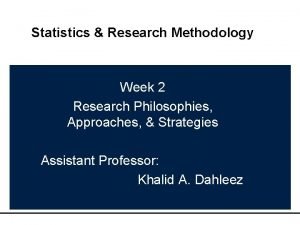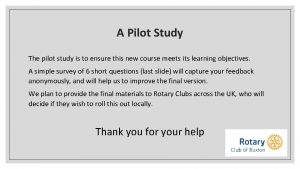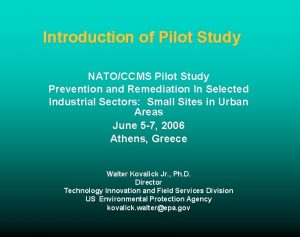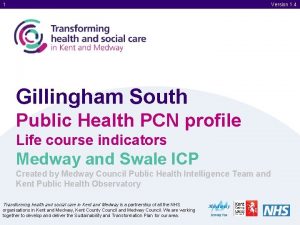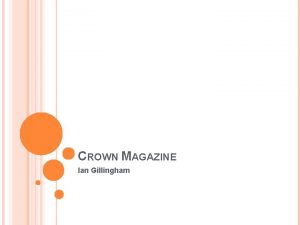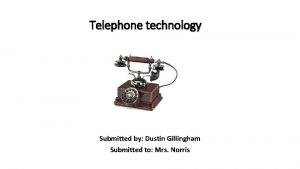The PILOT Design Study Will Saunders Peter Gillingham





















- Slides: 21

The PILOT Design Study Will Saunders, Peter Gillingham, Andrew Mc. Grath, Roger Haynes, AAO John Storey, Jon Lawrence, UNSW ASA, July 2008

PILOT overview Pathfinder for an International Large Optical Telescope – First major Optical/Infrared telescope in Antarctica – Proposed as joint Australian/European facility – To be sited at Dome C (3250 m, 123 E 75 S) – First light 2013 – 2. 5 metre Optical/Infrared telescope – NCRIS-funded design study now almost complete – Twin science and pathfinder role “Australia’s top priorities for new infrastructure funding this decade are to commence 10% participation in the SKA and an ELT, maintain 20% access to 8 -m class optical/infrared telescopes, continue operations of the AAO and Australia Telescope, and carry out the PILOT program. ” Decadal Plan, 2006 Dome C 3250 m altitude

Why Antarctica? Compared with best temperate sites: • Free atmospheric seeing 2 -3 median seeing ~0. 27" above 60 m best < 0. 1" • Isoplanatic angle 2 -3 • Coherence timescale 2 -3 • Scintillation noise 3 -4 • Thermal IR backgrounds 10 -100 • Precipitable Water Vapour 4 104 • Cloud 2 10 -6 0. 2" Jy/"2 Sky/telescope backgrounds 1 μm 10 1 DC 0. 27" Seeing CP 0. 8" DC 5. 4" Isoplanatic angle CP 2. 5" DC 7. 0 ms Coherence timescale 0 1 CP 3. 4 ms 0 2 Transparency μm 10 40

Why Dome C? Existing Concordia French/Italian station Well-characterised site Regular traverse route Can see geostationary satellites Low Auroral emission Relatively high sky coverage

Why Australia? No good O/IR astronomical sites No space program Proximity History of Antarctic Astronomy Large Antarctic Program Australian Antarctic Territory Dome C ● ● Casey Hobart ●

Why 2. 5 m? AO D/r 0 ~ 1 at 2. 4μm – diffraction-limited with fast guiding D/r 0 ~ 4 at 0. 8μm – optimal size for fast guiding Available from multiple vendors – reduced timecales, cost and risk Limit for passive support and ion-polishing Limit for convenient shipping Allows world-beating science Tip-Tilt Natural seeing D/r 0=1 D/r 0=4

Antarctic 'Challenges' Temperature -85°C to -30° Humidity ~150% Diamond dust (Ice crystals) Very turbulent and variable Seeing vs height d. T/d. Z = 0. 2 -1°C/m Less dark time? Less sky coverage Limited real-time data transfer Inaccessible in winter 100 m surface layer up to ~60 m d. T/dt up to 10°C/hour Temperature vs height -80 235 K 200 Temperature vs time and height for 1 day C -30

PILOT Design Overview – 2. 5 metre Ritchey-Chrétien telescope – Twin f/10 Nasmyth foci – Infrared optimised, but can use 0. 35μm-350μm – Diffraction-limited optics over 1° field – Wide-field pixel scale matched to median free seeing – Diffraction limited imaging over small fields at all wavelengths > 0. 5μm – Fast tip-tilt secondary – f/1. 5 meniscus Zerodur primary, actively ventilated – Active ventilation of mirror and telescope main structure – Installed on a 30 m tower to get above ground layer – Enclosure for temperature and humidity control – 24 hour remote operation with minimal human intervention Optics, thermal differentials, windshake, guiding, must all be twice as good as other terrestrial telescopes to do justice to the site

Tower – Get above worst of turbulent layer – Reduce air temperature gradient – But ~15°C warmer – Also windier, median ~7 m/s – Lowest mode 2 -3 Hz – Windshake < 0. 25", will clean up with tip-tilt – Probably aluminium – Assembled and built at site 1 year before telescope arrives Windshake

PILOT with air T=-48 C 150 mg/m 3 150% RH Must protect telescope from: (a) diamond dust (b) frost – 150% RH (c) wind shake (d) temperature gradient T=-48 C 75 mg/m 3 75% RH +5 Put telescope in dome, aperture as small as possible, ventilate continuously with dry air warmed to same temperature as aperture Also ventilate primary mirror, to (a) speed up thermalisation and (b) allow temperature differences 1 C or more ΔT (°C) 3 2 1 T=-53 C 75 mg/m 3 150% RH

Delivered image quality Tip-tilt removes most windshake and residual ground-layer turbulence. Using balloon or MASS/SNODAR values makes little difference to delivered image quality. Budget for entire PILOT system is 0. 2" d 80 (~0. 13" FWHM) Median delivered wide-field image quality ~0. 3" for iz. YJHK Median delivered narrow-field image quality < 0. 25" for iz. YJHK

Sensitivities Optical sensitivity comparable with 8 m. Greatest sensitivity gains over temperate sites at K, L, M, and mid-infrared. At K, background is 30 -40 times less than best temperate sites, image quality 2 -3 times as good. =>70 times faster than VISTA to given depth, 10 times faster than seeing-limited 8 -m. Only possibility to get NIR data of resolution and depth comparable to big optical surveys. Only possibility to get high resolution matching photometry for Spitzer warm mission (3. 6+4. 5μm). No comparison with JWST, but JWST takes 50 hrs/deg 2 just for slewing => wide-field Point Band λ Source (μm) AB, 5 σ, 1 hr g 0. 475 27. 6 r 0. 62 27. 1 i 0. 76 26. 7 z 0. 91 25. 8 Y 1. 04 25. 5 J 1. 21 25. 0 H 1. 65 24. 6 Kd 2. 35 25. 3 L 3. 76 21. 2 M 4. 66 19. 6

Science Drivers for PILOT: Science drivers must be driven by at least one of: – resolution over wide fields – low IR background – photometric stability – continuous coverage Four identified big science drivers so far: – H 2 in our Galaxy – The first light in the Universe – The earliest stellar populations – The equation of state of the Universe

Proposed Instrumentation 1. Fast optical camera, 0. 35 -1μm, 0. 02"/pix, 20" x 20". Diffraction-limited imaging over small fields. 2. Wide-field MIR camera, 10 -40μm, 1"/pix, 10' x 10', grisms/Fabry-Perot filter, R>10, 000. Terahertz? 3. Wide-field NIR camera: 1 -5μm, 0. 15"/pix, 4 K x 4 K, 11'x 11'. Also allows narrow-field diffraction limited z. YJHK imaging: 1 -2. 5μm, 0. 06"/pix, 4'x 4'. 4. Wide-field Optical camera, 0. 35 -1μm, 0. 08"/pix, 32 K x 32 K, 40' x 40'. Orthogonal Transfer Array CCDs? Overall, allows both wide-field and diffraction-limited imaging from 0. 4μm - 40μm.

Science Driver: Galactic ecology Molecular clouds are stellar nurseries, but H 2 very hard to detect directly. Best lines in mid-infrared, but sensitivity from ground is very poor. Use Fabry-Perot filter to carry out survey of H 2 0 -0 S(1) & S(2) 12+17µm lines (ground state lines of molecular hydrogen). Use phase shift to build up velocity cube with ~10 km/s 2" resolution. Will detect AV=1 clouds to < 200 K, enough to map surfaces of normal MC's Can do 12μm during daytime S(1) 160 K 17. 0µm S(2) 185 K 12. 3µm AV=1

Science Driver: Highest redshift stellar populations Spitzer warm mission will cover large areas at 3. 6μm+4. 5μm (7500 hours). Need K-band data to find 4000Ǻ break at z>6. Too hard for VISTA. PILOT survey speed comparable to Spitzer. Takes few hundred Myear to develop 4000Ǻ break. Detection at z~6 -7 pushes => galaxy formation at z>10 Re-ionisation epoch, Population III. Expect 103 -104 gals Can maybe get 3μm data with PILOT Spitzer VLT K-band PILOT Kdark

Science Driver: First light in the Universe Pair-Instability Super. Novae at z>10 SN 2006 gy brightest ever detected Metal-poor, Pair-Instability Super. Nova Expect similar supernovae from Pop III Can see 250 Msol in 1 hour at Kd to z=15 Expect to see few/year VISTA not sensitive enough JWST FOV too small (~1/deg 2)

Science Driver: Equation of State of the Universe via a large weak lensing survey – Measures evolution of equation of state of Universe, hence nature of Dark Energy – Most promising route to understanding Dark Energy (NASA, NSF, ESA…) – Need large sky coverage, very stable PSF, resolution limited – Antarctica gives 10 -100 fold advantage – As good as DUNE and much sooner 0. 7" 0. 3" 0. 1"FWHM 0. 5" FWHM

Other science: – Lensing masses for South Pole Telescope S-Z clusters – Near-field cosmology - g-K colours for ~109 stars in Milky Way and nearby galaxies – Star formation rate of the Universe via type II SN rate – Star cluster astroseismology – Exoplanet secondary transits – Microlensing by ice-giant and terrestrial planets – H 2 surveys of nearby galaxies – Pop III Gamma Ray Burst followup in K, L, M – Lucky imaging - Hubble from the ground – Source finder for GMT/JWST spectroscopy – Your idea here – Breakout session Tuesday lunchtime – PILOT science case poster PILOT 4 hrs

Beyond PILOT In general, can always do Adaptive Optics to < ½ the wavelength in Antarctica. So highest resolution is always comparable to telescope with twice the diameter WHAT? At Kd (only), sensitivity is greater than a telescope with twice the diameter 8 m-class telescope would be more sensitive and MUCH faster surveying than ELT at K Competitive with JDEM (ex SNAP), similar timescale 20 m-class telescope meets many original goals of OWL (Originally Was Larger) GMT-A LAPCAT

 Orton gillingham scope and sequence
Orton gillingham scope and sequence Heidi gillingham
Heidi gillingham Orton gillingham international
Orton gillingham international Heidi gillingham
Heidi gillingham Simon gillingham
Simon gillingham Rabbit words orton-gillingham
Rabbit words orton-gillingham Pilot study dalam penelitian kuantitatif
Pilot study dalam penelitian kuantitatif Commercial pilot oral study guide
Commercial pilot oral study guide Pilot experiment
Pilot experiment Sayem borhan
Sayem borhan Pilot study example
Pilot study example Shoulder orthopedic tests
Shoulder orthopedic tests Dasar cheeseman 1946
Dasar cheeseman 1946 Saunders
Saunders Saunders
Saunders Prof. brian saunders
Prof. brian saunders Retailer
Retailer Saunders
Saunders Saunders
Saunders Elsevier
Elsevier Saunders
Saunders Saunders research onion
Saunders research onion






